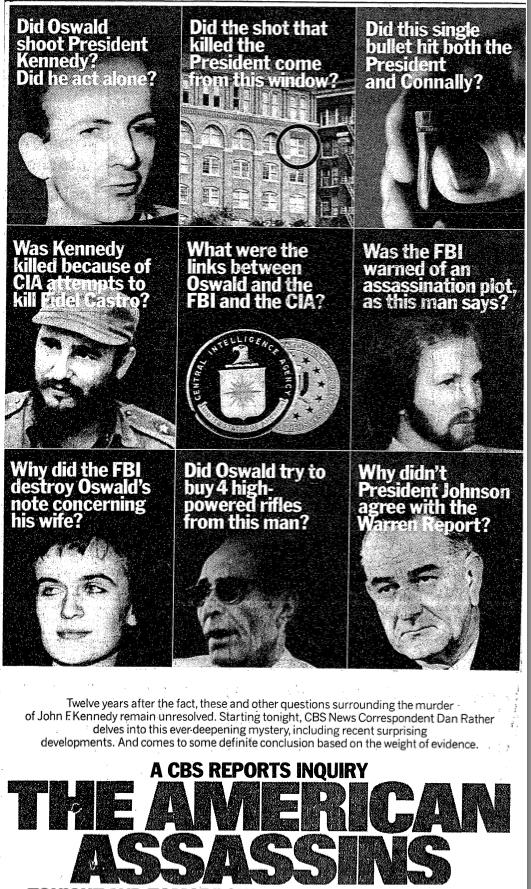Before moving to 60 Minutes at the end of 1975, Dan Rather was a correspondent in a few more CBS Reports and CBS News Special Reports, most prominently “CBS Inquiry: The American Assassins,” a multi-hour review of the shocking series of assassinations over the last dozen years—the murders of John F. Kennedy, his brother Robert, and Martin Luther King Jr., and the near-fatal shooting of Governor George Wallace. Producer Leslie Midgley recalls in his memoirs how Dan Rather called him one day and invited him for lunch to talk about an idea for a show: "Dan said he had become interested in this project because when he lectured on college campuses, the questions most frequently asked by students were about the assassinations. It was indeed often suggested that all three murders might have been linked in one enormous conspiracy." In a poll later commissioned by CBS, an astonishing 46 percent of the persons polled believed that there was some connection between the three assassinations and the attempt on Wallace. Only 38 percent believed the crimes were unconnected incidents. The others had no opinion.
The first two hours were devoted to Lee Harvey Oswald and John F. Kennedy. Broadcast on November 25 and 26, 1975, they were produced by Leslie Midgley and Bernard Birnbaum, with Dan Rather and David Culhane as reporters. In addition to extensive interviews, CBS used newly accessible documents: Abraham Zapruder’s film and the autopsy X-rays and photographs of the president's body, now that the five-year embargo imposed by Bobby Kennedy had expired. While the first hour investigated the death of JFK and the controversial findings of the Warren Commission and showed the Zapruder film on television for the first time, the second hour looked at the Oswald-Cuba connection and the role of the FBI and CIA in the assassination, focusing on their relationship to Oswald and the possible cover-up of information about the alleged assassination. At the end of the first two hours, Rather advocated for congressional investigation of the activities of the CIA and the FBI in this matter, especially about what they failed to tell the Warren Commission. He also said:
“We have cast some new light on the event and on the activities of the alleged assassin—and still the case cannot be closed. To discover a conspiracy, and other gunmen, in the murder of John F. Kennedy would have been a journalistic coup almost beyond imagining. We tried to do that in 1967 and could not. We couldn’t do it this time either.”
On November 27, 1975, the third hour was devoted to James Earl Ray and Martin Luther King. Produced by Leslie Midgley and Ernest Leiser, with Arthur Bloom as director and Dan Rather as reporter, it took up questions of conspiracy, the controversy surrounding the FBI’s role in the harassment of Dr. King and looked at the agency’s actions during the murder investigation. The Washington Post commented on how the show made a “powerful case for an ‘outside investigation’ of both the circumstances and motives surrounding the King assassination,” and called it “compelling journalism wrapped in the cold power of a well-constructed courtroom argument.”
A fourth hour investigated the murder of Senator Robert F. Kennedy by Sirhan Sirhan and the attempted assassinations of Governor George Wallace. Produced by Lee Townsend and Hal Haley, with Dan Rather as anchor and David Dick and Robert Schakne as reporters, the January 5, 1976, show included the results of a CBS News poll on public opinions regarding the lone assassin theory in each shooting.
The show was well received, with Variety concluding its positive review of the first two hours with the following: “Although cut and dried, Part I was an absorbing rehash, loaded with the ever-gripping film coverage of the tragic event and the hysteria surrounding it. But Part II became an utterly fasinating (sic) narrative as it traced the life of the accused assassin through the army, his Russian defection and, particularly, during the time between his return to the US and the killing of the President.” The Washington Post lauded the program for “demonstrating what can happen when a news organization decides to commit a great deal of time and a great deal of money to examine an important subject.”
“The American Assassins” was a big critical success and solidified Dan Rather’s image as an investigative journalist. The first two hours received the George Foster Peabody Award as outstanding documentary with the following praise: "A Peabody Award to The American Assassins wherein CBS News sought to meet head-on the deep concerns and continuing speculations of thoughtful Americans regarding the violent death of President John F. Kennedy. In-depth studies utilized virtually all available information: tapes, frame-by-frame film analysis, and interviews with experts. CBS News Correspondent Dan Rather and producer Leslie Midgley played leading roles in this rare and explosive effort."
To this day “The American Assassins” is considered one of CBS's best documentaries and one of the most important ones about the assassination of President Kennedy. In his book Now the News: The Story of Broadcast Journalism, Edward Bliss Jr. describes the series as “a formidable undertaking,” that owed much to its team of producers Leslie Midgley, Hal Haley, Ernest Leiser, Lee Townsend, and Bernard Birnbaum. Bliss details the content of the series:
CBS now had access to an accumulation of articles and books on the subjects [of the death of JFK], as well as insights from the assassination of two more public figures Robert Kennedy and Dr. King, and from the attempted assassinations of George Wallace. The original Zapruder film was shown during the first two hours devoted to questions persisting about the assassination of President Kennedy. Through the cooperation of Itek, a film analysis organization, CBS provided viewers with a frame-by-frame, split-second examination of the footage, showing in detail the sequence in which both the President and Connally were shot. Dr. James Weston, president-elect of the American Academy of Forensic Scientists, discussed the Kennedy autopsy report. The CIA’s relationship to Oswald and his Cuban connection were reported. The final two hours dealt in comparable detail with the assassination of Robert Kennedy and Dr. King and the attempt on Governor Wallace’s life.


